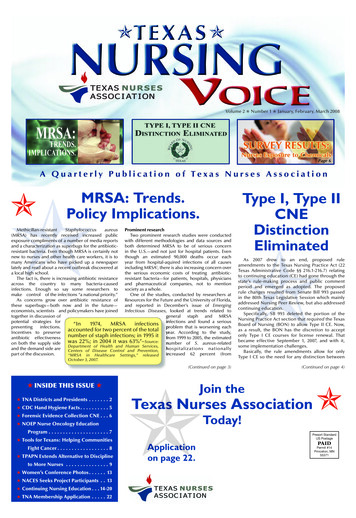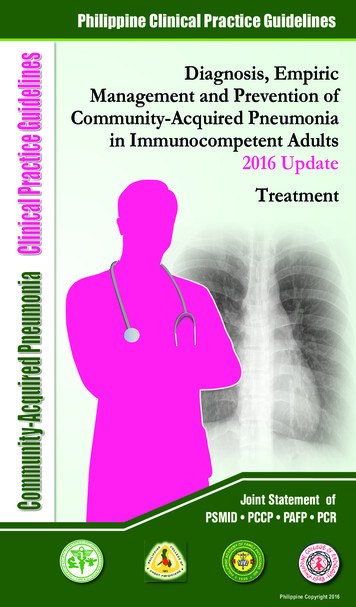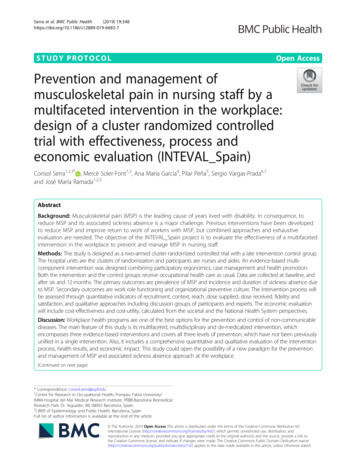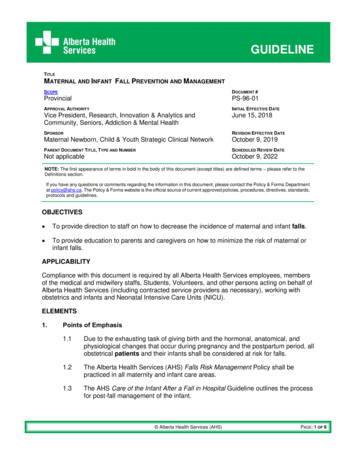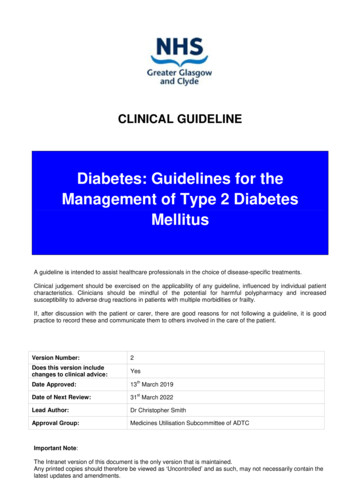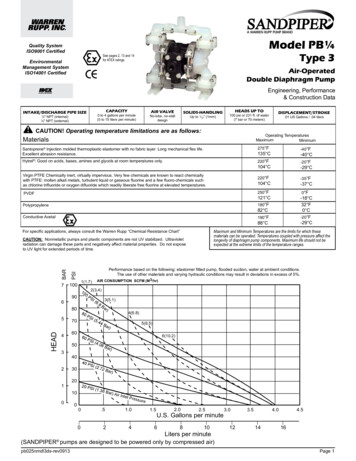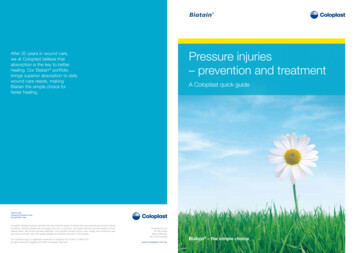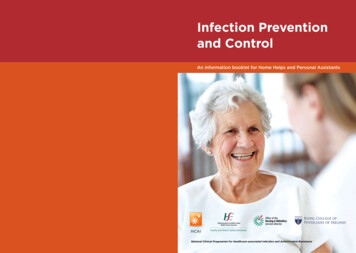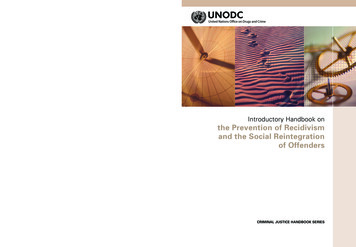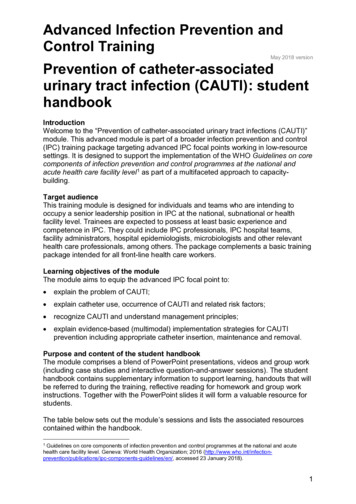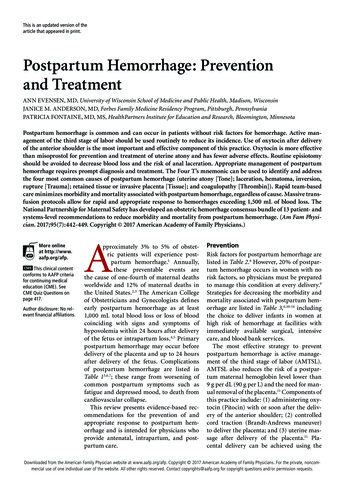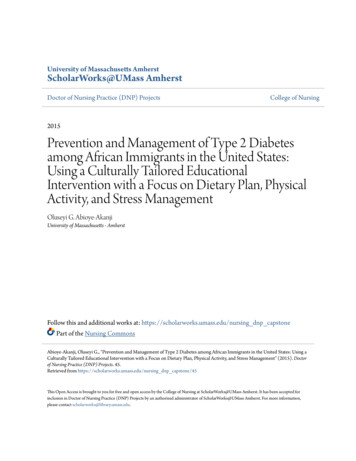
Transcription
University of Massachusetts AmherstScholarWorks@UMass AmherstDoctor of Nursing Practice (DNP) ProjectsCollege of Nursing2015Prevention and Management of Type 2 Diabetesamong African Immigrants in the United States:Using a Culturally Tailored EducationalIntervention with a Focus on Dietary Plan, PhysicalActivity, and Stress ManagementOluseyi G. Abioye-AkanjiUniversity of Massachusetts - AmherstFollow this and additional works at: https://scholarworks.umass.edu/nursing dnp capstonePart of the Nursing CommonsAbioye-Akanji, Oluseyi G., "Prevention and Management of Type 2 Diabetes among African Immigrants in the United States: Using aCulturally Tailored Educational Intervention with a Focus on Dietary Plan, Physical Activity, and Stress Management" (2015). Doctorof Nursing Practice (DNP) Projects. 45.Retrieved from https://scholarworks.umass.edu/nursing dnp capstone/45This Open Access is brought to you for free and open access by the College of Nursing at ScholarWorks@UMass Amherst. It has been accepted forinclusion in Doctor of Nursing Practice (DNP) Projects by an authorized administrator of ScholarWorks@UMass Amherst. For more information,please contact scholarworks@library.umass.edu.
Prevention and Management of Type 2 Diabetes among African Immigrants in theUnited States: Using a Culturally Tailored Educational Intervention with aFocus on Dietary Plan, Physical Activity, and Stress ManagementA Capstone Project PresentedByOluseyi Grace Abioye-AkanjiSubmitted to the Graduate School of theUniversity of Massachusetts, AmherstIn partial fulfillment of the requirements for the degree ofDOCTOR OF NURSING PRACTICEMay 30, 2015College of NursingApproved as to style and content byGenevieve E. Chandler, PhD, RN, College of Nursing Committee ChairJoan Roche PhD, RN GCNS-BC, College of Nursing Committee MemberJulius Kolawole, BEE, MSEE, MBA, Project Mentor
DedicationI dedicate this doctoral work to the glory of the Almighty God. I will keep on trustingHim for my future. Thank you, Lord.
AcknowledgementFirst and above all, I owe my deepest gratitude to the Almighty God for His faithfulnessthroughout the good and difficult times in my DNP journey. Lord I thank you, because it wasthrough your enduring grace and mercy that I was able to achieve this goal.The completion of this doctoral capstone project was possible with the support of severalpeople. I would like to express my sincere gratitude to all of them. First, I would like to thank mycapstone committee members for their dedications and support for this project. My committeechair, Dr. Genevieve Chandler, please accept my sincere appreciation for your enthusiasm,intellectual guidance and your tireless support at every stage of this work. Your broad scientificintuition and experience you shared with me have helped shaped my line of thought, and havetriggered many good ideas in this project. No words can fully articulate your role in thematerialization of this project. I feel incredibly privileged to have you as my advisor. I am indeedvery grateful to you. To my second committee member, Dr. Joan Roche, I cannot thank youenough for your support over the years; I really appreciate your invaluable contributions to makethe success of this project a reality. To my mentor, the President of the African Alliance ofRhode Island (AARI), Mr. Julius Kolawole, I thank you for the great work you do in ourcommunity and your support for this project. You provided critical input on each step of theproject implementation, and your ideas and contributions have been absolutely invaluable. Mysincere gratitude goes to all the African immigrants in Rhode Island who participated in thisproject, and to others who have contributed in one way or another to the success of the project,because without you, this capstone project would have remained a dream.I would like to sincerely thank all the staff and faculty members at the Umass AmherstSchool of nursing, who have contributed one way or the other to the success of my DNP degree.i
My special thanks to Dr. Jean DeMartinis for her support. I remember my first meeting with herat the beginning of my DNP journey. That meeting reinvigorated my enthusiasm and raised myspirits immeasurably about this program, and she has been very supportive from start to finish. Iam grateful to Karen Ayotte for her support and for always there to answer all my DNP programrelated questions.I also want to appreciate Dr. Cynthia Padula who was my graduate director at RhodeIsland College (RIC) while I was doing my MSN program. Even after I left RIC, she remained asupporter; she provided insight and direction right up until the end. For this, I am forever gratefulfor being there. I am really grateful to Mary Jean Francis, VP Performance Improvement of theProvidence Community Health Center, Dr. John Corsi and Dr. Natasha Hakim, for their support.I acknowledge Lucille Plasse, a certified diabetes educator, for sharing her expertise. Thank youfor your support and contribution to this project.This journey would not have been possible without the support of my family and friends.I am indebted to my sister Dr. Funke Bolujoko, a food and nutrition specialist for sharing hertime and expertise. I am also very grateful for your love, support and prayers. My dear husband,Akinkunmi, I have no words to express my deepest gratitude, but I thank you from the bottom ofmy heart for your love and support for my work and ambition. You are my most enthusiasticcheerleader, you are my best friend. It is your patience, sacrifice and impeccable understandingthat has helped me achieve this significant milestone. My loving children, Bolaji, Leke, Jadesolaand Aramide, you have grown up watching me study and juggle with school, family and work.The days and nights away from you while working on school assignments and, in particular, thisCapstone work has been truly difficult. I sincerely cherish your understanding and support.Jadesola and Aramide, I appreciate spending time proofreading my papers with a willingnessii
attitude. I thank you for sharing this entire amazing journey with me. I am very grateful to mypastors for their prayers, and words of encouragement. Finally, I appreciate my friend andcolleague Mofoluso who has been a source of inspiration throughout the years of this academicjourney despite the enormous work pressures we faced together.iii
AbstractPurpose: Close examination of epidemiological data revealed burdens of type 2 diabetes andcomplications particular to ethnic minorities in the United States including African immigrants.Literature reviews show poor dietary plan, physical inactivity, and poor stress management existamong African immigrants; contributing factors to these behaviors are cultural beliefs, barriers tophysical activity, knowledge deficit in stress management, healthy food choices and portioning.This DNP project focused on implementing a culturally tailored diabetes education with theobjective to increase participants’ knowledge on dietary planning, physical activity, and stressmanagement. Greater patient knowledge may lead to better diabetes management among Africanimmigrants in the U.S.Method: Three-sessions of culturally tailored diabetes education were delivered to Africanimmigrant adults (N 9) with Type 2 diabetes in Rhode Island. Behavioral change education wasbased on three of the American Association of Diabetes (ADA) self-care behaviors: healthyeating, physical activity, and stress management. Each session lasted approximately 2.5 hours.Demographic information of the participants was obtained using a questionnaire. A pre/post-testwas administered to measure participants’ knowledge base before and after educationintervention. Participants completed satisfactory survey questionnaires at the end of the program.Results: All of the participants had significant improvements in the knowledge areas of dietaryplan, physical activity, and stress management. One hundred percent (n 9) of the participantsreported great satisfaction of the program.Conclusion: The education program may serve as a model for up-to date culturally tailoreddiabetes education and information for African immigrants, and other ethnic minorities.iv
TABLE OF CONTENTSTable of Contents .PageAcknowledgement IAbstract .IVTable of Contents .VProblem Statement .1Evidence of the Problem .1Review of Literature . 5Data Sources and Searches .5Dietary Practices among African Immigrants a Function of theirCultural Practice and Beliefs . 6Exercise/ Physical Activity Practices among African Immigrants .7Stress management among African Immigrants .8Evidence Supporting Effective Management of Diabetes withDietary Plan, Physical Activity, and Stress Management .9Evidence Supporting Culturally Tailored Diabetes EducationIntervention in Ethnic Minorities .14Synthesis of Literature .18Theoretical Framework .20Project Setting Description . .21Description of Group, Population, Community Setting, and thekey Stakeholders .21v
Description of Resources, Facilitators, Constraints, or Barriersto Implementation .22Design/Methods. . .23Project design/ Protocol/Plan .23ClassStructure .24Goals and Objectives .26Cost .27Results, Data Analysis, and Interpretation .27Results .27Demographic Characteristics .28Data Analysis .29Test for Normality .30Outcome Results from Intervention .31Participant Satisfaction .33Discussion. .36Program Limitations .40Conclusions 42Implications and Recommendations .42References .44AppendicesA. Demographic Questionnaire 52B. Diabetes Knowledge on Nutrition Pre/Post-test .53vi
C. Diabetes Knowledge on Physical Activity Pre/Post-test .59D. Diabetes Knowledge on Stress Management Pre/Post-test .63E. Participant Satisfaction Survey 65vii
Problem StatementCaring for immigrants with chronic disease such as diabetes, demands more thanknowledge of clinical practice guidelines. Diverse cultural views and a wide range of paradigmsfor health and illness play a major role in how immigrants understand chronic diseases likediabetes (Gele & Mbalilaki, 2013).Increasing burden of type 2 diabetes (T2DM) and diabetes-related complications existamong ethnic minorities including African immigrants. Poor dietary habit, physical inactivity,and poor stress management are common practices among African immigrants. The factorscontributing to the unhealthy behaviors among this ethnic group have been reported to be lack ofinformation that include knowledge deficit on nutritionally appropriate food choices and portioncontrol, or that physical activity and stress management could improve diabetes outcomes.Culturally tailored educational approach promoting healthy lifestyle habits and patientempowerment has shown to be an effective strategy with the potential to decrease thedevelopment of complications related to T2DM among ethnic minorities. Various diabeteseducation intervention programs based on essential content from the American DiabetesAssociation and the National Diabetes Education program have been translated into ethnicminority community settings and are tailored to address the needs of the target communities inwhich programs were implemented. These culturally tailored diabetes intervention programshave demonstrated positive results, yet there is a significant gap in literature on culturallytailored programs for diabetes prevention in the African immigrant community in the U.S.Evidence of the ProblemIn 2011 immigrants made up 13 percent of the total U.S. population, meaning that one inevery eight U.S residents was an immigrant (Center for American Progress [CAP], 2013).1
African immigrants make up a highly racially diverse and rapidly growing group among ethnicminorities in the U.S. From 2000-2010, the African-born population in the U.S. grew from881,300 to 1.6 million (Migration Information Source [MIS], 2011).Chronic diseases such as diabetes affect 25.8 million people, or 8.3% of the U.S.population (Center for Disease Control [CDC], 2011). Diabetes has become a significant publichealth challenge for the U.S., affecting both Americans and the foreign-born population.Complications such as neuropathy affect up to 60-70% of people with diabetes. Neuropathyincreases the chance of foot ulcers and limb amputation. Retinopathy from diabetes is the biggestcause of blindness in working aged adults in the U.S.; after 15 years of diabetes, 2% of peoplebecome blind, and about 10% develop severe visual impairment. Approximately 30% of peoplewith diabetes have renal failure (CDC, 2011). In addition, the increasing diabetes prevalencebears an additional financial burden to the health care system. The total cost of diagnoseddiabetes in the U.S. in 2012 was 245 billion; 176 billion in direct medical costs, and 69billion in reduced productivity. After adjusting for population age and sex differences, averagemedical expenditures among people with diagnosed diabetes were 2.3 times higher than whatexpenditures would be in the absence of diabetes (American Diabetes Association [ADA], 2013).A comprehensive review of epidemiological data revealed greater burdens of diabetesand diabetes complications among ethnic minorities including African immigrants. Compared tonon-Hispanic white, Blacks in general are almost twice as likely to suffer from Type 2 diabetes(T2DM) and to experience diabetes-related blindness and lower-limb amputations. Blacks arealso two to six times more likely to have kidney disease (CDC, 2011; African AmericanCommunity Health Advisory Committee [AACHAC], 2009). Although, robust epidemiologicaldata on diabetes health outcomes are lacking for the African immigrant population in the U.S.,2
one major complicating factor is that the existing data tends to categorize blacks in general andforeign-born blacks in particular as a homogenous group (Shepard, 2008). However, the WorldHealth Organization (WHO) data, the International Diabetes Federation (IDF) data, and researchstudies suggest high prevalence of T2DM in Africa, among the African immigrants to the U.S.,Canada, and Europe (Shipp, Francis, Fluegge, & Asfaw, 2014; Creatore et al. 2010; Venters &Gany, 2009; WHO, 2008, IDF, 2003). In 2006, the number of people with diabetes in all Africancountries was 10.4 million and is expected to increase to 18.7 million by 2025 (WHO, 2008).The top five countries with the highest number of people affected by T2DM in Sub-SaharanAfrica are Nigeria-about 1.2 million people, South Africa-841,000, the Democratic Republic ofCongo-552,000, Ethiopia-550,000, and Tanzania-380,000 (IDF, 2003). The undiagnosed casesare estimated to be as high as 60% to 80% in Cameroon, Ghana, and Tanzania (WHO, 2008).The WHO also reported that in the year 2000, about 113,000 people in Africa died fromdiabetes, 561,600 were permanently disabled, and 645,800 experienced temporary disablementfrom diabetes (WHO, 2008). A systematic review of Moroccan immigrants in Europe found thatthere were higher rates of diabetes in these Moroccans than their European cohorts (Venters et al.2009). Another study that explored the health status of Liberian immigrant subgroups showedthat three of the leading health complaints in this population were diabetes, hypertension andanxiety/stress (Venters et al. 2009). Creatore et al. (2010) conducted a population-based studyinvolving immigrants to Ontario, Canada to evaluate the distribution of risk for diabetes in thispopulation. The authors found that, as compared with immigrants from Western Europe andNorth America, risk for diabetes was elevated among immigrants from sub-Saharan Africa (oddratio [OR] for men 2.31, 95% CI 2.17-2.45; OR for women 1.83, 95% CI 1.72-1.95). Increasedrisk became evident at an early age (35-49 years) and was equally high or higher among women3
as compared with men. T2DM and high blood pressure was reported as the most frequent andalarming emerging health condition among the East African immigrants (Somalia’s andEthiopians) in central Ohio. Some of these immigrants viewed diabetes as a new disease, andsome of them referred to it as an epidemic (Shipp et al. 2014). In support of these reports,anecdotal evidence gathered from the African immigrant community in Rhode Island (RI)suggests that diabetes threatens the health of this population. Two interviewees living in RIstressed that the major question in their community is “Why do we have so many cases ofdiabetes?”Poor dietary habit, physical inactivity, and poor stress management have been found to berelatively common among African immigrants (Abioye-Akanji, 2013; McGuigan, 2010; Ndiaye,2009; Owens, Piccinin, & Lai, 2009; Uwakweh et al. 2013). When poor dietary habits arecombined with sedentary lifestyle and poor stress management, it can quickly lead to obesity,high prevalence of diabetes and poor diabetes management and diabetes outcomes.Diabetes prevention and management programs have shown the benefits of using lifestyleinterventions such as a healthy diet, physical exercise, and stress management to reduce diabetesrisks (ADA, 2013; Colberg et al. 2010; Ghosh et al. 2009; Tay et al. 2014; Umpierre et al. 2011).The National Diabetes Education Program [NDEP], 2009) suggested that diabetes preventionand management should focus on reducing and/or eliminating the high rates of diabetes-relatedmorbidity and mortality through understanding of the cultural beliefs and behavioral factors thataffect the self-management of diabetic patients.Various diabetes education intervention programs have been translated into ethnicminority community settings and are tailored to address the needs of the target communities inwhich programs were implemented. These culturally tailored diabetes intervention programs4
have been shown to demonstrate positive results (Bryan, 2010; Choi & Rush, 2012; Osborn,Amico, Cruz, O’Connell, Perez-Escamilla, Kalichman et al. 2010; Philis-Tsimikas, 2008; Rosal,Ockene, Restrepo, White, & Borg, 2011).The purpose of this quality improvement (QI) project is to implement a culturally tailoreddiabetes management educational intervention program for African immigrants in the U.S. with aparticular focus on dietary plans, physical activity, and stress management, in the hope ofincreasing participants’ knowledge. Knowledge increase in dietary plans, physical activity, andstress management may lead to better diabetes management among African immigrants in theU.S.Review of LiteratureData sources and searchesA review of the literature was conducted with search strategies that include the Medline,CINAHL, PubMed, and the National Guideline Clearinghouse databases. The followingkeywords were used: “type 2 diabetes mellitus and disease management and meta-analysis”,“type 2 diabetes mellitus and dietary practices an
ScholarWorks@UMass Amherst Doctor of Nursing Practice (DNP) Projects College of Nursing 2015 Prevention and Management of Type 2 Diabetes among African Immigrants in the United States: Using a Culturally Tailored Educational Intervention with a Focus on Dietary Plan, Physical Activity, and
